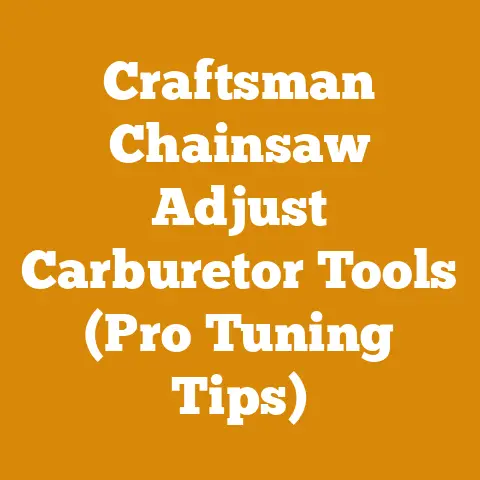Pellet Furnace Add On Solutions (Effortless Heat for Woodworkers)
Have you ever felt the frustration of meticulously crafting beautiful wooden pieces in your workshop, only to be shivering while you work? The biting chill can not only make the process uncomfortable, but also impact your precision and creativity. Maintaining a consistent and comfortable workshop temperature, especially during the colder months, is crucial for productivity and the quality of your woodworking projects. That’s where the idea of integrating a pellet furnace add-on comes in.
As a seasoned woodworker and someone who’s spent years both felling trees and meticulously shaping them, I understand the importance of a comfortable working environment. I’ve worked in everything from unheated barns where my fingers went numb to modern, climate-controlled workshops. Let me tell you, the difference in the quality of my work, and my enjoyment of it, is immense. In this guide, I will delve into the world of pellet furnace add-ons, offering practical solutions that can transform your woodworking space into a haven of warmth and efficiency. I’ll cover everything from assessing your heating needs and selecting the right add-on to installation tips and safety considerations.
Understanding the Need: Why Pellet Furnace Add-Ons?
Before diving into the specifics, let’s clarify why a pellet furnace add-on might be the perfect solution for your woodworking shop. Traditional heating systems, such as electric heaters or propane furnaces, can be costly and inefficient, especially in larger, less insulated spaces. Wood stoves offer an alternative, but they require constant tending and can create uneven heating. Pellet furnaces, on the other hand, provide a consistent, automated heat source, burning compressed wood pellets made from recycled wood waste. This makes them an environmentally friendly and cost-effective option.
An “add-on” system specifically refers to integrating a pellet furnace alongside your existing heating system, or adapting it to heat specific zones, like your woodworking shop. This allows you to customize your heating, avoiding the expense of replacing your entire system. It is a strategic, targeted approach to heating.
Key Benefits of Pellet Furnace Add-Ons:
- Cost Savings: Burning wood pellets is typically cheaper than electricity, propane, or oil.
- Consistent Heat: Automated feeding systems ensure a steady temperature.
- Eco-Friendly: Pellets are made from renewable wood waste.
- Zoned Heating: Focus heat where you need it most, like your workshop.
- Reduced Firewood Handling: No need to constantly chop and stack wood like with a traditional wood stove.
Step 1: Assessing Your Heating Needs
Before you even think about purchasing a pellet furnace add-on, you need to understand your heating requirements. This involves calculating the size of your workshop, assessing its insulation, and considering your climate.
1. Calculate the Square Footage:
Measure the length and width of your workshop in feet. Multiply these two numbers to get the square footage.
Example: A workshop that is 20 feet long and 15 feet wide has a square footage of 300 square feet (20 ft x 15 ft = 300 sq ft).
2. Assess the Insulation:
The level of insulation in your workshop will significantly impact the amount of heat required to maintain a comfortable temperature. Consider the following:
- Wall Insulation: Are your walls insulated? What is the R-value of the insulation? (R-value measures thermal resistance; the higher the R-value, the better the insulation.)
- Ceiling Insulation: Is your ceiling insulated? What is its R-value?
- Window Insulation: Are your windows single-pane or double-pane? Are they drafty?
- Door Insulation: Are your doors well-sealed and insulated?
A poorly insulated workshop will require a much larger and more powerful pellet furnace than a well-insulated one.
3. Consider Your Climate:
The climate in your area will also influence your heating needs. If you live in a region with harsh winters, you’ll need a more powerful furnace than someone in a milder climate.
- Heating Degree Days (HDD): Look up the heating degree days for your location. This is a measure of how cold it is in your area during the heating season. You can find this information from local weather services or online resources.
- Average Winter Temperatures: Consider the average low temperatures during the winter months.
4. Estimate BTU Requirement:
BTU (British Thermal Unit) is a measure of heat energy. To estimate the BTU requirement for your workshop, you can use the following formula:
-
BTU/hour = (Square Footage x Temperature Difference x Insulation Factor)
- Square Footage: The square footage of your workshop (as calculated in step 1).
- Temperature Difference: The difference between your desired indoor temperature and the average outdoor temperature during the coldest months. For example, if you want to maintain a temperature of 65°F inside and the average outdoor temperature is 20°F, the temperature difference is 45°F.
-
Insulation Factor: This factor depends on the level of insulation in your workshop. Use the following guidelines:
- Poorly Insulated: 8-10
- Moderately Insulated: 6-8
- Well Insulated: 4-6
Example: Let’s say you have a 300 sq ft workshop, you want to maintain a temperature of 65°F, the average outdoor temperature is 20°F, and your workshop is moderately insulated.
- BTU/hour = (300 sq ft x 45°F x 7) = 94,500 BTU/hour
This is just an estimate. It’s always better to err on the side of caution and choose a pellet furnace with a slightly higher BTU rating than you think you need.
Personal Experience: I once underestimated the heating needs for my small 400 sq ft shop. I bought a smaller pellet stove with an output of only 25,000 BTU. It was barely enough to keep the chill off, and it ran constantly, burning through pellets like crazy. I ended up having to upgrade to a larger unit with a 40,000 BTU output, which made a huge difference. Don’t make the same mistake I did!
Step 2: Selecting the Right Pellet Furnace Add-On
Once you have a good understanding of your heating needs, you can start researching different pellet furnace add-on options. There are several factors to consider:
1. Type of Pellet Furnace:
- Freestanding Pellet Stoves: These are self-contained units that can be placed anywhere in your workshop. They are relatively easy to install and are a good option if you don’t have an existing ductwork system.
- Pellet Furnace Inserts: These are designed to be installed in an existing fireplace. If you have a fireplace in your workshop, this can be a convenient option.
- Pellet Furnaces for Central Heating: These are designed to be integrated into your existing central heating system. They can heat your entire home, including your workshop. This is a more complex installation but can be a good option if you want to heat your entire home with pellets.
2. BTU Output:
Choose a pellet furnace with a BTU output that is appropriate for your workshop’s size and insulation. As mentioned earlier, it’s better to err on the side of caution and choose a slightly larger unit than you think you need.
3. Hopper Capacity:
The hopper is the container that holds the wood pellets. A larger hopper will allow you to go longer between refills. Consider how often you want to refill the hopper when choosing a pellet furnace.
4. Efficiency:
The efficiency rating of a pellet furnace indicates how much of the fuel’s energy is converted into heat. Look for a furnace with a high efficiency rating to save money on fuel costs.
5. Features:
Some pellet furnaces come with additional features, such as:
- Thermostat Control: Allows you to set a desired temperature and maintain it automatically.
- Automatic Ignition: Eliminates the need to manually light the furnace.
- Programmable Timer: Allows you to schedule when the furnace turns on and off.
- Remote Control: Allows you to control the furnace from a distance.
6. Budget:
Pellet furnaces can range in price from a few hundred dollars to several thousand dollars. Set a budget before you start shopping and stick to it.
Example Pellet Furnaces and Their Applications:
| Pellet Furnace Type | BTU Output | Hopper Capacity | Features | Best For |
|---|---|---|---|---|
| Freestanding Pellet Stove | 40,000 | 60 lbs | Thermostat control, automatic ignition, programmable timer | Small to medium-sized workshops (300-600 sq ft) with no existing ductwork. |
| Pellet Furnace Insert | 50,000 | 50 lbs | Thermostat control, automatic ignition, remote control | Workshops with an existing fireplace. |
| Pellet Furnace (Central) | 80,000 | 120 lbs | Thermostat control, automatic ignition, programmable timer, multiple zone control | Larger workshops (800+ sq ft) or for heating the entire home in addition to the workshop. Requires integration with existing ductwork. |
Case Study: My Shop Upgrade
I recently upgraded my woodworking shop, which is about 600 square feet and moderately insulated. I decided to go with a freestanding pellet stove with a 40,000 BTU output and a 60-pound hopper. I chose this model because it had a thermostat control, which allows me to maintain a consistent temperature in the shop, and it was relatively easy to install. The total cost was around $2,500. I was initially worried that the 40,000 BTU output might be overkill, but I’m glad I went with the larger unit. It heats the shop quickly and efficiently, even on the coldest days.
Step 3: Installation Considerations
Installing a pellet furnace add-on can be a relatively straightforward process, but it’s important to follow the manufacturer’s instructions carefully. If you’re not comfortable working with tools or electricity, it’s best to hire a professional installer.
1. Location:
Choose a location for your pellet furnace that is:
- Level: The furnace should be placed on a level surface.
- Non-Combustible: The furnace should be placed on a non-combustible surface, such as concrete or tile.
- Away from Flammable Materials: Keep the furnace away from flammable materials, such as wood, paper, and fabrics.
- Accessible for Maintenance: Ensure that you can easily access the furnace for cleaning and maintenance.
- Near an Electrical Outlet: The furnace will need to be plugged into an electrical outlet.
2. Venting:
Pellet furnaces require venting to exhaust combustion gases. The venting system should be installed according to the manufacturer’s instructions and local building codes.
- Direct Vent: This type of venting system vents directly through an outside wall.
- Vertical Vent: This type of venting system vents through the roof.
3. Electrical Connection:
Pellet furnaces require an electrical connection to power the auger, blower, and other components. The furnace should be plugged into a dedicated circuit with the appropriate amperage.
4. Pellet Storage:
You’ll need a place to store your wood pellets. Choose a location that is:
- Dry: Keep the pellets dry to prevent them from crumbling.
- Accessible: Make sure the pellets are easily accessible for refilling the hopper.
- Away from Flammable Materials: Keep the pellets away from flammable materials.
Installation Steps (General Guidelines – Always Refer to Manufacturer’s Instructions):
- Prepare the Location: Clear the area where you will be installing the pellet furnace. Ensure the floor is level and non-combustible.
- Install the Venting System: Follow the manufacturer’s instructions to install the venting system. This is a critical step for safety.
- Connect the Electrical Supply: Plug the furnace into a dedicated electrical circuit with the appropriate amperage.
- Place the Furnace: Carefully place the furnace in its designated location.
- Connect the Venting to the Furnace: Connect the venting system to the furnace.
- Test the Furnace: Follow the manufacturer’s instructions to test the furnace.
Safety Considerations:
- Carbon Monoxide Detector: Install a carbon monoxide detector in your workshop to alert you to the presence of this dangerous gas.
- Smoke Detector: Install a smoke detector in your workshop to alert you to the presence of fire.
- Regular Maintenance: Perform regular maintenance on your pellet furnace to ensure that it is operating safely and efficiently. This includes cleaning the venting system, ash removal, and inspecting for any signs of damage.
- Consult Local Codes: Adhere to all local building codes and regulations when installing your pellet furnace.
My Installation Experience:
When I installed my pellet stove, I was particularly careful about the venting. I made sure to use the correct type of venting pipe and followed the manufacturer’s instructions to the letter. I also hired a professional to inspect the installation to ensure that it was done correctly. It cost me a bit extra, but it gave me peace of mind knowing that my family and my shop were safe. I also installed a carbon monoxide detector right next to the stove, and another in the adjacent office space.
Step 4: Fueling and Maintenance
Once your pellet furnace add-on is installed, you’ll need to learn how to fuel and maintain it properly.
1. Choosing Wood Pellets:
- Quality: Look for high-quality wood pellets that are made from 100% hardwood. Avoid pellets that contain bark, dirt, or other contaminants.
- Ash Content: Choose pellets with a low ash content. This will reduce the amount of cleaning required.
- Moisture Content: Choose pellets with a low moisture content. This will improve their burning efficiency.
2. Fueling the Furnace:
- Turn Off the Furnace: Before refueling the furnace, turn it off and let it cool down.
- Open the Hopper: Open the hopper lid and pour in the wood pellets.
- Do Not Overfill: Do not overfill the hopper.
- Close the Hopper: Close the hopper lid securely.
3. Regular Maintenance:
- Ash Removal: Remove the ash from the ash pan regularly. The frequency of ash removal will depend on the type of pellets you are using and how often you are using the furnace.
- Venting System Cleaning: Clean the venting system at least once a year. This will help to prevent blockages and ensure that the furnace is venting properly.
- Inspect for Damage: Regularly inspect the furnace for any signs of damage, such as cracks, leaks, or corrosion.
Specific Maintenance Tasks and Tools:
- Ash Pan Cleaning: Empty the ash pan every 1-2 weeks, depending on usage. Use a metal shovel and a metal bucket to collect the ash.
- Heat Exchanger Cleaning: Clean the heat exchanger every month to remove soot and ash buildup. Use a wire brush and a vacuum cleaner to clean the heat exchanger.
- Venting System Inspection and Cleaning: Inspect the venting system annually for blockages or damage. Clean the venting system with a chimney brush.
- Burn Pot Cleaning: Clean the burn pot regularly to ensure proper airflow. Use a scraper or wire brush to remove any clinkers or ash buildup.
Pellet Storage Tips:
- Dry Location: Store pellets in a dry location to prevent moisture absorption.
- Elevated Storage: Store pellets on pallets or a raised platform to protect them from ground moisture.
- Covered Storage: Cover pellets with a tarp or in a shed to protect them from rain and snow.
- Pest Control: Implement pest control measures to prevent rodents or insects from damaging the pellets.
Personal Anecdote: I learned the hard way about pellet quality. I bought a few tons of what I thought were cheap pellets, but they turned out to be full of bark and dust. My stove clogged constantly, and I was spending hours cleaning it. Lesson learned: Spend a little extra for good quality pellets; it’s worth it in the long run.
Step 5: Optimizing Performance and Efficiency
Once you have your pellet furnace add-on up and running, there are several things you can do to optimize its performance and efficiency.
1. Proper Airflow:
Ensure that the furnace has adequate airflow. Do not block the air vents.
2. Thermostat Settings:
Adjust the thermostat settings to maintain a comfortable temperature without wasting energy.
3. Insulation:
Improve the insulation in your workshop to reduce heat loss.
4. Sealing Drafts:
Seal any drafts around windows and doors to prevent heat from escaping.
5. Regular Cleaning:
Perform regular cleaning and maintenance to ensure that the furnace is operating efficiently.
6. Pellet Quality:
Use high-quality wood pellets to improve burning efficiency and reduce ash buildup.
Advanced Optimization Techniques:
- Barometric Dampers: Install a barometric damper in the venting system to regulate airflow and improve combustion efficiency.
- O2 Sensors: Some pellet furnaces have O2 sensors that automatically adjust the air-to-fuel ratio for optimal combustion.
- Smart Thermostats: Use a smart thermostat to program heating schedules and remotely control the furnace.
Strategic Insights:
- Zoned Heating: Use zoning valves or dampers to direct heat to specific areas of your workshop.
- Heat Recovery Ventilation (HRV): Install an HRV system to recover heat from exhaust air and preheat incoming fresh air.
Cost-Benefit Analysis:
- Insulation Upgrades: Investing in insulation upgrades can significantly reduce heating costs over the long term.
- Smart Thermostats: Smart thermostats can pay for themselves in energy savings within a few years.
Case Study: Reducing My Pellet Consumption
After a particularly harsh winter, I decided to focus on improving the efficiency of my pellet stove. I started by sealing all the drafts around my windows and doors with weather stripping. I also added some extra insulation to my attic. These simple changes made a noticeable difference in my heating costs. I estimate that I saved about 15% on my pellet consumption that year.
Step 6: Troubleshooting Common Issues
Even with proper installation and maintenance, you may encounter some common issues with your pellet furnace add-on. Here are some troubleshooting tips:
1. Furnace Won’t Start:
- Check the Power: Make sure the furnace is plugged in and that the circuit breaker is not tripped.
- Check the Hopper: Make sure the hopper is full of pellets.
- Check the Igniter: The igniter may be faulty.
2. Furnace Produces Little or No Heat:
- Check the Airflow: Make sure the air vents are not blocked.
- Check the Burn Pot: Make sure the burn pot is clean.
- Check the Venting System: Make sure the venting system is not blocked.
3. Furnace Smokes Excessively:
- Check the Venting System: Make sure the venting system is properly installed and not blocked.
- Check the Pellets: Make sure you are using high-quality wood pellets.
- Check the Airflow: Make sure the furnace has adequate airflow.
4. Furnace Makes Unusual Noises:
- Check the Auger: The auger may be worn or damaged.
- Check the Blower: The blower may be worn or damaged.
- Check for Obstructions: Check for any obstructions in the auger or blower.
Troubleshooting Chart:
| Issue | Possible Causes | Solutions |
|---|---|---|
| Furnace Won’t Start | No power, empty hopper, faulty igniter, safety switch activated | Check power supply, fill hopper, replace igniter, reset safety switch |
| Little or No Heat | Blocked airflow, dirty burn pot, blocked venting system, low-quality pellets | Clean air vents, clean burn pot, inspect and clean venting system, use high-quality pellets |
| Excessive Smoke | Improper venting, low-quality pellets, inadequate airflow, dirty furnace | Inspect and correct venting system, use high-quality pellets, ensure adequate airflow, clean furnace |
| Unusual Noises | Worn or damaged auger, worn or damaged blower, obstructions in auger or blower, loose components | Replace auger, replace blower, remove obstructions, tighten loose components |
Seeking Professional Help:
If you are unable to troubleshoot the issue yourself, it’s best to contact a qualified technician for assistance.
Personal Experience: I once had my pellet stove shut down in the middle of a cold snap. After checking all the obvious things, I realized that the igniter had burned out. I was able to replace it myself with a new one I ordered online, but if I hadn’t been comfortable working with electricity, I would have called a professional.
Step 7: Safety First: Essential Precautions
Safety should always be your top priority when working with any heating appliance, including pellet furnace add-ons.
1. Read the Manual:
Always read and understand the manufacturer’s instructions before installing or operating your pellet furnace.
2. Carbon Monoxide Detectors:
Install carbon monoxide detectors in your workshop and test them regularly.
3. Smoke Detectors:
Install smoke detectors in your workshop and test them regularly.
4. Proper Venting:
Ensure that the venting system is properly installed and maintained.
5. Regular Maintenance:
Perform regular maintenance on your pellet furnace to ensure that it is operating safely and efficiently.
6. Keep Flammable Materials Away:
Keep flammable materials away from the furnace.
7. Supervise Children and Pets:
Supervise children and pets when the furnace is in operation.
8. Emergency Procedures:
Know what to do in case of a fire or carbon monoxide leak.
Detailed Safety Checklist:
- Venting System Inspection: Inspect the venting system annually for leaks, blockages, or corrosion.
- Carbon Monoxide Detector Testing: Test carbon monoxide detectors monthly and replace batteries annually.
- Smoke Detector Testing: Test smoke detectors monthly and replace batteries annually.
- Clearance from Combustibles: Maintain a minimum clearance of 36 inches from combustible materials.
- Fire Extinguisher: Keep a fire extinguisher readily accessible near the pellet furnace.
- Emergency Contact Information: Post emergency contact information near the pellet furnace.
Legal and Regulatory Compliance:
- Building Codes: Comply with all local building codes and regulations when installing your pellet furnace.
- Permits: Obtain any necessary permits before installing your pellet furnace.
- Insurance: Check with your insurance company to ensure that your pellet furnace is covered by your homeowner’s insurance policy.
My Commitment to Safety:
I always prioritize safety in my workshop. I have multiple carbon monoxide detectors and smoke detectors, and I regularly inspect my pellet stove and venting system. I also make sure to keep flammable materials away from the stove and to supervise my children and pets when it is in operation.
Strategic Advantages of Pellet Furnace Add-Ons
Beyond the immediate benefits of warmth and cost savings, pellet furnace add-ons offer several strategic advantages for woodworkers.
1. Increased Productivity:
A comfortable workshop temperature can significantly improve your productivity and the quality of your work.
2. Reduced Material Waste:
Consistent temperature and humidity levels can help to prevent warping and cracking of wood.
3. Improved Tool Performance:
Some tools, such as adhesives and finishes, perform better in warmer temperatures.
4. Enhanced Comfort:
A warm workshop is simply a more enjoyable place to work.
5. Environmental Benefits:
Burning wood pellets is a renewable and sustainable heating option.
Long-Term Investment:
A pellet furnace add-on is a long-term investment that can pay for itself in energy savings and increased productivity.
Maximizing Your Investment:
- Energy Audits: Conduct an energy audit of your workshop to identify areas where you can improve energy efficiency.
- Government Incentives: Take advantage of any government incentives or rebates for installing a pellet furnace.
- Tax Credits: Claim any applicable tax credits for installing a pellet furnace.
Personal Reflection:
I’ve found that having a warm and comfortable workshop has not only made me more productive but has also made woodworking a more enjoyable experience. I can now spend hours in my shop without feeling cold or uncomfortable, and I’m able to focus on my work without distractions.
1. Review Your Needs:
Revisit your assessment of your heating needs and determine the appropriate size and type of pellet furnace for your workshop.
2. Set a Budget:
Establish a budget for your project, including the cost of the furnace, installation, and fuel.
3. Research Options:
Research different pellet furnace models and compare their features, prices, and reviews.
4. Consult Professionals:
Consult with qualified professionals, such as HVAC contractors or pellet furnace installers, to get advice and estimates.
5. Plan the Installation:
Develop a detailed plan for the installation, including the location of the furnace, venting system, and electrical connections.
6. Obtain Permits:
Obtain any necessary permits from your local building department.
7. Schedule the Installation:
Schedule the installation with a qualified installer or, if you’re comfortable, tackle the project yourself.
8. Purchase Fuel:
Purchase a supply of high-quality wood pellets.
9. Test and Optimize:
Test the furnace after installation and optimize its performance for maximum efficiency.
Continuous Improvement:
Continuously monitor the performance of your pellet furnace and make adjustments as needed to improve its efficiency and comfort.
By following these steps, you can successfully implement a pellet furnace add-on project and transform your woodworking shop into a warm, comfortable, and productive space. Remember to prioritize safety and consult with professionals when needed.






